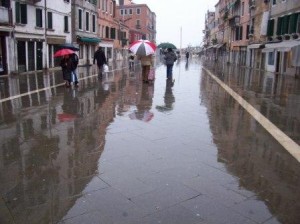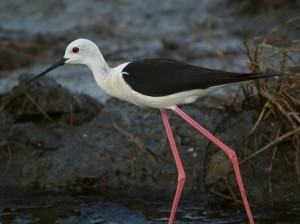Having reviewed the barest basics of acqua alta, and the barest technical outlines of the “floodgate” project intended to keep Venice as dry as the Nebraska Sand Hills, I’d better warn you that not everybody is on board.
“This is a way of funneling a huge amount of money to business allies of the government,” a city councilor told The Christian Science Monitor last year. “There are better alternatives but they were never considered. There is a big question mark over whether it will really work.”
So has anybody spoken up? Only thousands of people. The project been protested, sued against, blocked and stalled in all sorts of ways for 30 years (yes: it’s taken three decades to get this thing to where it is today), and even now the arguments pro and con continue to be lobbed back and forth between the opposing believers.

There have been a few times when it appeared that perhaps the project would be annulled for various reasons: lack of money, the bizarre absence of the required Environmental Impact Statement, legal loopholes that kept being found and then quickly closed. But nothing has been able to stop its implacable progression toward completion. It’s like throwing gravel at the Kraken.
By the end of 2009, despite all the myriad stops, starts, and slowdowns, 63 percent of the project had been completed. There isn’t enough money to restore historic palaces and churches which are visible every day, but somehow money has been found to block exceptional high water, an event which might occur four to seven times a year. Or maybe not at all. You may have noticed that the weather is not operated by the Swiss railway system.
But doesn’t everybody in Venice want to save their city from the sea?
In a word: No. At least not everybody in Venice wants this to be the way to tame the tides. In fact, it is difficult to find anyone who is not directly benefiting from the project who thinks it’s a good idea. Quite the contrary.
There are four general categories to which most objections belong. Let’s look at the them:
Political: Not much to say here, because this is a sphere in which nothing is ever resolved. The political fortresses from which accusations have been hurled like stone cannonballs are very well defined: right, left, extreme right, extreme left, and a mass of foot soldiers in the middle with all sorts of commingled ideas. But if you don’t belong to some group, nobody will ever listen to you (not that they listen so much anyway). Only thing is, each group has an agenda which includes lots of other issues as well, so if you join one to reject the MOSE project, you could find yourself on mailing lists as being against a batch of other undertakings as well. Maybe you’re not against those, maybe you don’t even care.

Others point out that the Special Law for Venice, by which federal funds are earmarked for the city, specifically authorized interventions to stop pollution and re-establish the morphologic equilibrium of the lagoon. It doesn’t appear that MOSE will satisfy either of those requirements. Au contraire.
Even more important, each side considers it a good day’s work if it has managed to frustrate or thwart the other. No other result is really necessary. This reality is the cholesterol in the political metabolism, hardening and constricting the arteries through which ideas and energy and good will might otherwise have flowed to produce something beneficial to the organism (the city and the lagoon) as a whole.
Economic: Every enormous public work since the Great Pyramid of Cholula (and perhaps even that one) has exceeded its projected cost. The original date of completion was given as 2010. This has now moved to 2014. Hence the costs have also changed. MOSE was budgeted at $4.5 billion, more or less, depending on whose estimates you follow, a number which it has now overtaken without even slowing down to wave. In 2008, the cost had risen to $7 billion.
There is also the cost/benefit aspect to consider. I think it’s fair to say that anyone who is not personally involved would concede that the costs and the benefits of this colossal undertaking do not come anywhere near matching up.
One foreign newspaper reported that $30 million a year is lost in business each time the Piazza San Marco floods (meaning that these 40-some shops can make $30 million in six hours, when the tide is in? Wow…. ). But let’s say acqua alta does cost $30 million, even if that number is cited only by the people who would benefit from the effects of such a prediction.
MOSE, as already mentioned, not only has cost $7 billion by now with 35 percent and two more years to go. Few if any mention is made of the estimated cost of annual maintenance of this behemoth: a mere $11.5 million. Of course, this will be eternal income to the interested parties. The project will be finished, but maintenance is forever.

But that isn’t the crux of the objections to its price tag. Simply put, it’s that money dedicated to MOSE is lost to anything else.
Stories which focus on the cost/disturbances inflicted by a few hours of water on the ground don’t tend to refer to the financial scorched earth the MOSE project has made of the quality of daily life for everybody everywhere in Venice, not just the shopkeepers around San Marco. Paying for this project, which might bring a temporary benefit to the city a couple of times a year, has deprived the city of the money required for numerous, more humble needs (schools, ambulances, restoration of monuments and private buildings, etc.).
Just about every facility or service which is important to city life, more important than the occasional need to put on the Wellies, has been cut in some way. The administrations’s constant cry “We have no money” tends not to explain why.
Environmental: When UNESCO designated Venice as a World Heritage Site in 1987, it specifically included the entire Venetian lagoon. It is the second-largest wetland in Europe (Europe has lost 2/3 of its wetlands in the last 100 years). It is vital area for plants, fish, and birds, some of which are already endangered. Every year some 200,000 birds winter, nest, or pause here in their twice-yearly migrations. One could make a reasonable case that the lagoon has a value which rivals that of Venice.
Local, national and international environmental groups have raised countless alarms about the effect of this project on the lagoon environment. Prominent among these are the World Wildlife Fund, LIPU (the bird people), RAMSAR (international wetland protection), Italia Nostra, and more, down to a local citizens’ group called simply “NoMose.”
In one of many reports, Italia Nostra summarized its concerns: “The dams will render permanent the Lagoon’s environmental imbalance: The deep channels dredged in the last century through its outlets will become concrete. The erosion that is now eating away the Lagoon’s precious wetlands would become permanent, and this rich coastal lagoon, protected by European law, would be transformed into an area of open sea.”

The deepening of the channels to accommodate the cement frame for the caissons has already intensified the tidal flow — I can see and feel it every day. Faster and stronger tides mean many things: More erosion of the bottom sediments (one of the defining characteristics of a lagoon environment), consequent damage to the eelgrass which serves to anchor the sediment and which provide a habitat for many small marine species, and so on up the chain.

There is also great concern about the physical impact of the materials used, specifically the caissons’ zinc plates (zinc is forbidden by European law) as well as the anti-fouling paint, which contains many toxic chemicals such as TBT compounds, assorted heavy metals, and solvents. Coats of anti-fouling paint have to be periodically renewed, so that will contribute another dose of this stuff to the environment. Damage to the lagoon and the Adriatic is seen as virtually inevitable. I must mention that the builders deny this.
Data and forecasts which justify the project have been questioned by many different sources. Some of the data does not appear anywhere but in the builders’ documents.
Engineering: Plenty of engineers from assorted countries, those who are not directly involved in the project, have always voiced doubts about whether it’s likely to work the way it’s supposed to.

Some of their concerns are:
- It has never been completely tested.
- The only positive assessment rendered by an independent panel of engineers was restricted to saying whether the design could function as intended — that is, whether it would work as designed. Virtually all other independent evaluations have been extremely cautious, if not negative. No engineers except the builders, to my knowledge, have risked saying whether it should be built. Maybe that’s not what engineers are supposed to do. UNESCO wrote an analysis in 2003 which concisely evaluated the project’s drawbacks, including the meteorological predictions on which it is based.
- There are discernible aspects of the design which must ALWAYS function PERFECTLY (difficult in a salt-water environment),or they won’t perform the way they’re supposed to. For one thing, there is a high risk of the seal between the caissons not being watertight. If water begins to pass between the caissons, the wall they form could be dangerously compromised (fancy word for “weakened”). If the caissons for any reason do not align perfectly, ditto.
- If for some reason encrustation of any sort remains on the caissons and/or their anchoring hinges (salt-water is great for fostering encrustations of minerals and critters), the barrier may not rise in the manner or at the rate necessary.
- If sea-level increases fulfill the darker prophecies, not only will the caissons have to be used more often and kept in place for longer periods of time than predicted (undergoing stresses for which they were not designed), but eventually their maximum height may not be enough.
- After decades of legal battles, the design was already obsolete before construction even began. Thirty years is an eternity in engineering terms. (Imagine buying a car designed 30 years ago.) Whatever its flaws, it should have been modified or updated in some way by now. But no.
Perhaps most important, critics point out that this titanic construction flouts several principles sacred not only to the hydraulic engineers of the Venetian Republic (not exactly amateurs) but also to commonly-accepted principles of environmental and engineering prudence. Those principles are:
- The project should be gradual, to permit evaluation of the results obtained at each stage and, if necessary, permit changes to the original plan. This obviously isn’t the case here.
- The project should be reversible. MOSE obviously isn’t.
- The project should be experimental. By “experimental” the Special Law clearly intends that a project should be tested experimentally before it is definitely approved and funded and built. That never happened.
How did this project ever get approved?
I can’t swear that I know. Here is what I do know: That the project was assigned to the Consorzio Venezia Nuova, a consortium which the city has exclusively authorized (some have used the word “monopoly”) to intervene in the lagoon. This consortium is made up of more than 20 Italian engineering and construction companies — in a word, businessmen. Scientists who promote or defend the project are often consultants for the consortium.
So here we are. It’s too late to be any use, but I’d like to recall a comment by Wendell Berry, the farmer/writer/environmental critic.
“A good solution to a problem,” he said, “is one which does not create new problems.”
Seems kind of obvious, when you think about it.
Next: How will it all come out?

12 Comments
I really enjoyed read your article, very interesting …
Hey, I just thought of one great reason to have the Mose project in place.
What if the city not only raised it when Hightower tides are seen on the horizon, but also when cruises ships are seen. Sort of “the wall of Troy”. Then all you have to worry about is a floating horse. See, this wall could be useful after -all!
Otolini
This is what exactly I was searching, the information was overall very useful for me, thanks a lot.
sounds correct butthe amount of sarcasm makes this site not seem as credible as it could be especially since as one person said, this is what I was really looking for.
I don’t know what in particular “sounds correct” to you, but the sarcasm is the virtually inevitable reaction to years spent witnessing idiocy, mendacity, and assorted self-serving maneuvers here that manage not to be maddening only because one becomes so accustomed to them that they lose their force. But when they do reach the maddening stage, sarcasm results. Sorry. Any information I publish can be confirmed by non-sarcastic sources.
Or It could be that the site when I’m gonna have to cite this as a source, is called “I am not making this up” on a how to make a blog site. Other than that thank you for the info and it looks like Erla Zwingle (you? maybe you posting her story I don;t know) is a journalist so if he asks I can at least use that as defense. Sorry for being blunt great source of info though.
You would cite my blog as a source on how to make a blog? That’s encouraging and I thank you. But “other than” what? You are speaking in riddles. I am Erla Zwingle; nobody else has been published on my blog, so far, but if they were, I would certainly credit them. I am a journalist. Anything else about me can be found on my “About” page. If you’re using me “as defense,” what are you defending yourself against? Who is “he”? What an interesting and enigmatic life you live.
Hi,
I’m an Italian scientist working on anti-fouling alternative solutions in Sweden. I wrote an email to “consorzio venezia nuova” in order to get some informations about the strategies they intend tu put in act in order to minimize the risk of malfunction of the caissons as consequence of the formation of large colonies of fouling organism inside and outside the caissons. In my opinion the weight gain caused by the formation of colonies of barnacles and mytilus could make ineffective the floating system, i.e. even if you pump air in the caissons the caissons will rest on the bottom because the 3/4 of the volume will be occupied by fouling organisms. It could have been a great opportunity for cooperation between the consortium and scientific community, a challenging problem to solve together.
But the consortium answered “what kind of paint are you selling?”. The thing is that I´m not selling anything else that several years experience, a great network of anti fouling scientists all over the world and a EU financed project that we started in sept. 2012 and which will deal with similar problematic on cruising surfaces as boats.
I proposed them opportunity, innovation, research, in other world, science, but the Consortium seems more on the let’s make it happen here and now.
whatever. I still can’t find anywhere some data regarding what countermeasures will be taken in this project as anti-fouling system. This would be great to know, it could help transparency and open a discussion. But maybe it is exactly what has to be avoided. Discussion!
I feel sorry for not being useful as a scientist in my country. This means that i will bit it and will keep doing my impact aboard as I already have done the past few years.
(if someone have some data about the antifouling countermeasure they gone to use please put here some link ore reference)
//Emiliano
A little reply by little me isn’t much use here, except to say that every example of the attitude of people who have the fate and future of large important things (the lagoon…Venice…) makes me cringe and shriek. Of course I’m not surprised to hear their response to you. They spent 30 years battling every rational criticism or comment from 360 degrees in order to just do what they wanted. So now they’re doing it and they’re perfectly happy. So your comments are just tiny little pieces of fluff to them.
Hey, I was wondering what your sources for all this information are?
I wrote this quite some while ago, and did not annotate my story, so I can’t be particularly specific. I would say generally articles, studies, and interviews that I found by searching the internet. Being able to read Italian is a big help in this regard, it gives you a much wider array of material. If you have a question about a particular issue or point, let me know and I will give you the source.